Hugh D. Soar examines arrows from the past, and reveals what they might be able to show us about historical warfare and craftsmanship
Traditional archery is not noted for mystery, but certain items recovered from the ‘Mary Rose’ have had traditionalists – and others with a nose for the unusual – puzzling over, of all things, arrows.
As we all know, or should, arrows traditionally have one of four profiles. These are parallel (straight) bobtailed (tapering from pile to nock), breasted or chested (tapering from nock to pile) and barrelled (tapering to both nock and pile from broadly the shaft centre).
However, among the many shafts recovered from the ship, there is a fifth profile, known to those who are familiar with it as ‘saddled’. That is, a shaft with two distinct ‘barrellings’, separated by a central ‘dip’. Over thirty of these were examined for ‘Weapons of Warre’ – the Mary Rose Society’s archaeological report – and their details, including a sketched profile are contained within Chapter 8 of Part One.
But, although ‘saddled’ shafts no longer survive, we may ask – what was their purpose? Let us speculate. The profile embodies one ‘barrel’ forward of centre, and one aft. It also has a substantial head, as does a ‘bobtailed’ shaft. So, it incorporates two aspects of other profiles. What are these? A bobtailed arrow carries a heavy head to slam through plate, while ‘barrelling’ reduces vibration, particularly immediately following release, thereby (in theory at least) improving distance. Since the ‘saddled’ shaft includes the primary characteristics of both, did some sixteenth-century theorist hope to produce a battle shaft capable of delivering a heavy head with a shaft profile designed to reduce vibration and thus increase its effective distance? Obviously we will never know, and so far to my knowledge no-one has carried out the experimental archaeology necessary to find out.
Whatever the reason, the ‘saddled’ shaft has for too long been in history’s dustbin. The thought that an out-of-the-ordinary sixteenth-century concept may actually have got further than the drawing board may be the vital spark necessary to kick-start some contemporary theorist with a similar bright idea. We shall never know the true purpose of the ‘saddled’ shaft, however, if someone within the English War Bow Society (of which body I am proud to be Patron) cares to carry out practical experiment I for one would be interested to know the results.
A word of caution though. There are two alternative explanations contained within ‘Weapons of Warre’. One suggestion from distinguished bowyer Chris Boyton, is that water immersion, causing degradation of the shafts, may be the reason for the odd shape, while I myself suggested the possibility of poor workmanship. In retrospect however, there is perhaps too much symmetry between the 32 shafts noted with this profile for either of these alternatives to be likely, and we are therefore left where we began, with a mystery.
There are one or two other curiosities associated with these survivors from our archery past. Of the total of 9,600 arrows shown on the ship’s manifest, 2,303 whole arrow shafts were recovered, and of these a random sample of 1,051 were examined in detail. Poplar predominated, followed by birch. No ash shafts were sampled, suggesting that, despite Roger Ascham extolling its virtue for military arrows in his work ‘Toxophilus’, it was seemingly not always the fletcher’s choice.
A greenish substance remained on the shaftments of a number of arrows, and subsequently speculation arose that copper verdigris had been applied – possibly to counteract possible damage by infestation – at or shortly after the stage of fletching. To check whether verdigris was present, one typical shaft was taken to the Royal Armouries for x-ray fluorescence analysis.
This produced an interesting result, since unexpected traces of zinc were found at all points of the shaft up to 100mm from the cone. Copper traces were also found along the shaft, in particular an amount at the shaftment, and a lesser, but still appreciable quantity, at the cone. The presence at the shaftment is understandable, but copper at the head was unexpected. So, why was it there? The coating of arrowheads with copper is not unknown; examples have been excavated. Now, copper is poisonous when introduced into the bloodstream, and wounding with an arrow bearing copper traces at its head would certainly hasten death. There is some evidence that the French accused the English of using poisoned arrows. Could this be proof?
While technically the war-bow remained part of this country’s armoury until well into the seventeenth century, and indeed featured in occasional skirmishes during the Civil War, its steady replacement by the hand gun lessened the need for practice. Although the old Statute requiring adult males to shoot at no less than 220 yards was no longer generally observed, this was recognised as a target distance by those recreational archers who shot on London’s Finsbury Fields, some of whom had, in the early seventeenth century, formally created the Society of Finsbury Archers, the earliest English recreational archery club. ‘The ‘Eleven Score Target’ was an annual event for this Society from 1672 until 1752. Oddly, archery practice remained Statute Law until the mid nineteenth century.
The transition from military archery to shooting for pleasure brings another mystery, for although, as might be expected, bow draw-weights dropped, arrow lengths shortened. It is not clear exactly when this happened, since no datable seventeenth century arrows survive, but by the mid-eighteenth century arrow shafts were just 27 inches long; pale imitations of the 31 inch battle shaft shot by lusty English bowmen.
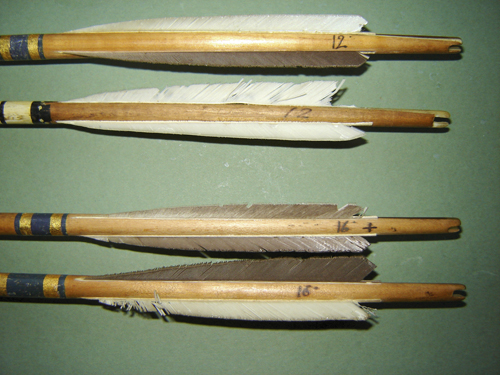
Shaftments and figures indicating distances in roods appropriate to two early 19th century English butt shafts
We know something of the making of the seventeenth century recreational arrow from an account preserved in an early book. The final phases in the preparation of the shaft are said to have been: ‘Poising the arrows is to know whether the pair of arrows be of an equal weight as they are of a length. Turning them is to give them a twist in one’s hand to know whether they be straight’. Although the pair were evidently compared with each other and presumably corrected if there was a difference, we can only guess whether, at such an early date, the weight in coinage was marked on the shaft. Paired arrows were shot individually as late as the early nineteenth century.
A pair of arrows in my collection, Scottish and datable to the 1760’s, have straight 27 inch self-shafts, four inch triangular fletchings and – curiously – turned brass piles, the earliest examples of this form known to me. The markings tell something of them. An X gives the weight (10 shillings measured against silver coinage) 27 indicates the length and 25 (yards) the distance appropriate to the arrow. These belonged to a member of the Royal Company of Archers who shot at a short distance indoor butt. Comparison shows remarkable similarity. Each weighs 725 grains, and has a spine deflection of .250 thou.
While marking weight by coinage was a regular feature of arrow-making by the turn of the eighteenth century, there was another means of identification used by a member of the ‘Woodmen of Arden’ – a prestigious late eighteenth century archery society. This Society regularly shot ‘the roods’, an early expression for shooting at butts. A rood was an archaic measure of 7½ yards.
Late eighteenth century or early nineteenth century arrows in my keeping are marked either 12 or 16 (roods) indicating their suitability for 90 yards or 120 yards. These 27 inch long straight self-shafts also appear to have been ‘paired’, and it has been interesting to compare four, each marked 12, for weight and spine, and also head, since there is a deal of difference between these early heads. Heads were made individually by wrapping a piece of sheet metal around a stopping and then brazing the join, a process which carried on until well into the twentieth century and the coming of brass and metal turned piles.
Comparison between two of these shafts showed deflection values of .625, and.650 thou: and an exact weight match of 310 grains. Two others however each weighed 380 grains, although the shafts showed deflections of .525 and .300 thou: With ‘spine values’ yet to be scientifically determined, they may well have been supplied as a ‘matched’ pair.
Finally, a word about fletchings. Those familiar with early arrows will know of the long triangular shape so closely associated with them. What may not be widely known, however, is the reason for the late nineteenth century change to the shield shape largely in use today. It seems that one day in the late 1870’s, Henry Elliott, a member of Aston Park Archers, and a gun-smith by profession, accidentally broke the first three inches from one of his fletches. Some archers might have removed and replaced the affected feather, but not Mr. Elliott. Removing a similar amount from the other two and refining the shape to a shield, he shot the arrow and noticed that it flew better and further. The principal arrow-makers were not slow to pick up this change and the result – as they say – is history.


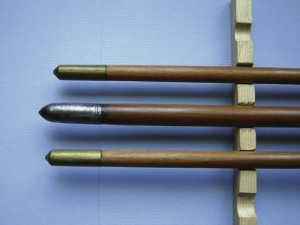
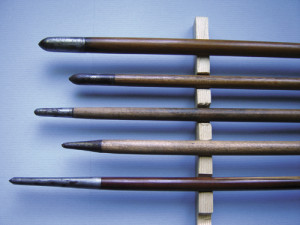
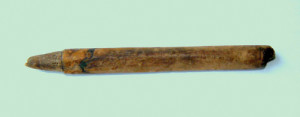
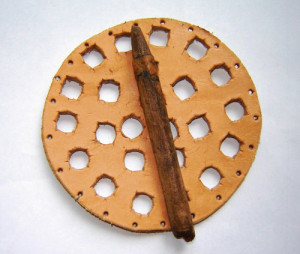
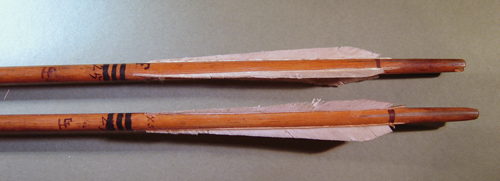
I’m afraid your lusty English bowmwn were actually shooting 36″ shafts as per the Tower of London inventories.
Since the Mary Rose arrow discovery the Tower of London Inventories from the mid 1300’s have been translated in 2012 from Latin, Anglo Norman and middle English and give a comprehensive view of bow and arrow manufacture, purchase and distribution which now cast doubt on the purpose of the Mary Rose arrows.
There were only two categories of arrow, the yard long war arrow and everything else. Everything else was all commercial arrows for hunting, target and flight shooting. Almost all, both commercial and military, were made of aspen (Poplar Tremulus). The flights of commercial arrows were whipped (also known as waxed) and in most cases the heads were pinned, bound or heat shrunk on so the arrow could be removed intact from target or prey, these arrows were made to be reusable and could last many years whereas the military arrow heads were push fit so as to come apart when trying to remove from shields or flesh and unwhipped as they were considered a single use missile.
The Mary Rose arrows were whipped and show signs by staining of having their heads bound, either way these were expensive reusable arrows not to be fired over water never to be seen again which is why they were left in the hold as cargo. They also seem to have their heads bound on judging by the staining and copper traces…these were expensive arrows and not be shot over water never to be seen again. On the other hand if I were opening an Arrows”R”Us superstore in Calias this wide selction of unmatched products would be exactly what I would take.
Fom the inventories 1356_1341
“In his expenses we find one fletcher paid 6d. a day for 244 days making 300 sheaves
of arrows from arighshaftes from stock, feathers (plumis pro pennatione) purchased
at 8s., wax for 3s. 4d. and a dog skin for 6d., £6 13s. 10d. in total. This total of
45,744 arrows was therefore assembled at a rate of 187 per fletcher per day; no other
source known to the writer gives that degree of detail about the work-rate of a
medieval fletcher.”
This is @12 pence for 24 arrows, no mention of waxed thread and certainly not enough time to whip even 25% of the arrows.
On the other hand we have an order from the Tower for hunting arrows for the King which would be up to 32’ and have had tanged heads and been whipped @6 shillings for 24 arrows.
Only after 1310 do there start to be any records describing 6′ bows with yard-long arrows; a Court crime record describes one used in a murder case in 1314. Depictions of 6′ bows drawn to the ear, in full-scale longbow fashion, appear in the Luttrell Psalter of about 1330, and most graphically and accurately in the Smithfield Decretals manuscript of 1340 (Fig.7).
Arrowheads surviving from prior to 1300 have sockets 0.3″ to 0.35″ wide; arrowheads from the longbow era, 1330s onward, have sockets 0.45″ to 0.5″ wide, designed for larger and heavier arrows and warheads. It is clear that a major scaling-up of bow design took place between 1300 and about 1320, bringing it up to a weapon capable (with strength and practice) of shooting much heavier arrows with much heavier and more lethal warheads.
The longbow’s step-change period can thus be placed with reasonable confidence as being between 1300 and 1320. Imports of yew bowstaves increased; an order for 2,000 from Spain is recorded, and others from the Baltic. Critically, by the early 1330s the 6′ bow with 36″ arrow had become adopted as the military standard for all future Crown orders which is why we never see an arrow order with a measurement unless it is an unusual arrow or first time order like this……
On 17 December 1324 an order was sent by Edward II to the sheriff of
Nottingham for the provision of nine springalds, five for quarrels of the length of ¾
of a yard including heads (27 inches), four for quarrels of 5/8 of a yard (22.5 inches),
and 1,000 quarrels, half of 27 inches and half 22.5 inches in length, to be delivered at
Hull.
The yard corresponds to the Kings Rod yard which had been around since 1160.
Ref…arrow length…. the drawing of fletchers from the mid 1300’s. The barrel is known a pipe which is 126 gallons and stands about 38 to 40 inches high it is half a Tun and slim built (pipe?) as in the picture and what is even more interesting is that the feathers are shield cut and appear to stand quite high..
This now is the oldest treatise on archery yet discovered. Translated from French(1515) and is quite adament that sheaf arrows were glued only and not whipped.
https://www.archerylibrary.com/books/gallice/
Contents of "The Art of Archery", printed probably around 1515. Edition by Henri Gallice, from notes of a late 15th century manuscript, 1901, translated by H. Walrond.
of "The Art of Archery", printed probably around 1515. Edition by Henri Gallice, from notes of a late 15th century manuscript, 1901, translated by H. Walrond.
http://www.archerylibrary.com